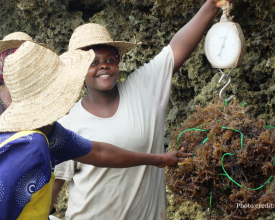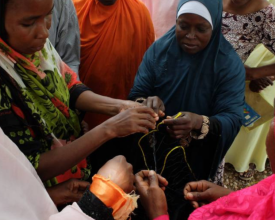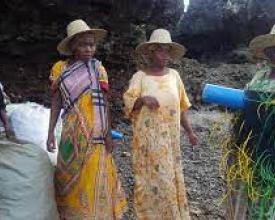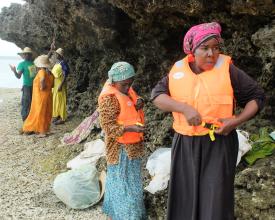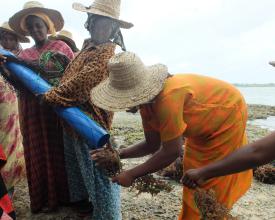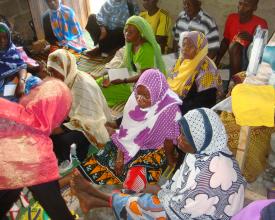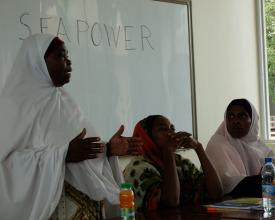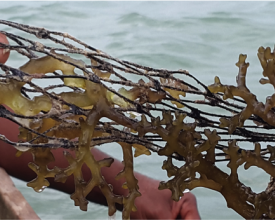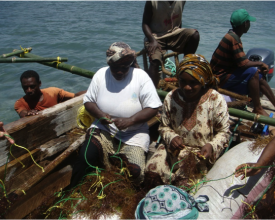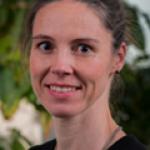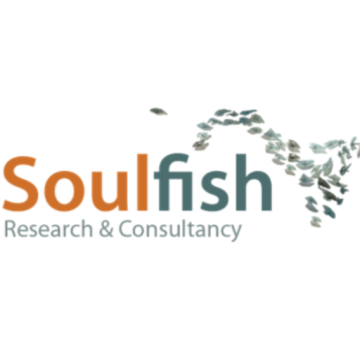
Sea PoWer: an innovative seaweed farming technology to empower women
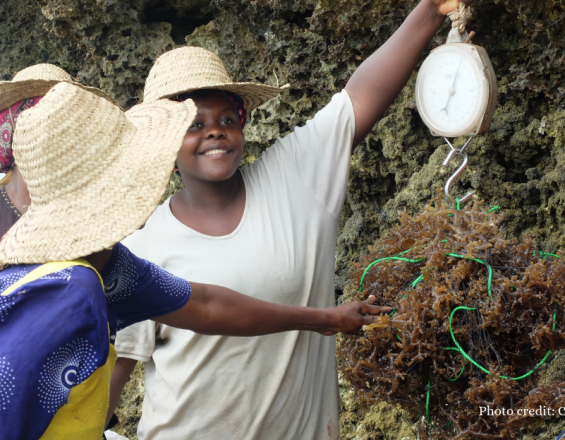
In Zanzibar, seaweed farming is a small-scale but important livelihood activity, carried out at 80% by women. Recently, declines in production were observed, proved to be mostly due to climate change.
Tubular nets - an innovation piloted in the context of the Sea PoWer initiative, have shown promise over the traditional "off-bottom" peg and rope technology to improve seaweed productivity and local ecosystem conditions. However, tubular nets are used in deeper waters, and thus, require swimming or boat handling skills that most women do not have. Establishing seaweed farms in deeper water, using new technologies, could only be a successful adaptation option, with institutional support, significant investment and through the empowerment of women and the participation of local communities.
Context
Challenges addressed
Technological challenges:
The traditional method of farming seaweed in shallow water using the off-bottom "peg and rope" method is ineffective because of:
- High water temperatures and salinity variations due to climate change, which lead to disease ("ice-ice") and prevent the growth of the high-value Cottonii seaweed species.
- Seaweed loss, as it breaks off from the ropes in the currents.
- The seaweed is of low quality (epiphytes).
Social and economic challenges:
- Women face poor working conditions:
- They sit in seawater for long periods untangling their ropes.
- They carry heavy materials and harvests on the head.
- They suffer from stings and cuts from urchins and sharp shells as they wade in the water.
- Prices paid to the producers for the harvested seaweed are very low.
- There is no transformation and value addition of seaweed on Zanzibar.
- There are very few livelihood alternatives to seaweed farming for women .
Location
Process
Summary of the process
The goal of Sea PoWer is to achieve, in partnership with the women seaweed producers, an adapted seaweed farming technology – the tubular nets – that transforms their lives, supports their aspirations, farming and livelihoods needs, helps the sustainable integration of seaweed farming in the local economic and ecological landscapes, and is ready for scaling out and widespread adoption in the entire Western Indian Ocean.
Sea PoWer initiative has adopted a progressive approach combining innovation with empowerment, to simultaneously improve seaweed productivity and women's work conditions, as well as act as a vector of emancipation by improving their position, decision-making and visibility in the Zanzibar society.
At its core is the co-generation of knowledge and the capacity building of women seaweed farmers in terms of technical know-how, social capital, self-esteem and confidence through interactions with the project team, fellow producers, male members of their communities, seaweed buyers and other industry stakeholders.
Building Blocks
Building women's capacity and social capital
Sea PoWer facilitated the formation of two groups of women producers. It involved them in the design of the tubular net technology (e.g. testing net length and harvesting method) to ensure that the technology was adapted to their needs.
SeaPoWer developed the capacity of producers to:
- Construct tubular nets.
- Plant and monitor seaweed growth.
- Record keeping.
- Be safer at sea (e.g. wear life jackets on the boat).
- Handle boats with men.
- Construct basket traps to catch fish under the nets.
Sea PoWer also encouraged women to work together as a group, as several people are needed to seed and harvest the nets and supported their organisational capacity.
Enabling factors
Availability of equipment and technical support. Sea PoWer supplied the materials to build the tubular nets and farm seaweed with them (fishing nets, ropes, PVC tubes, boat). This enabled to lift constraints related to accessing equipment, and perceived risk of engaging in this new form of production. Sea PoWer closely monitored their uptake of the technology.
Willingness to cooperate. Social collaboration was highlighted by women engaged with Sea PoWer as a critical enabling environment to promote knowledge sharing for adaptation.
Lesson learned
Factors outside the technology itself, such as perceptions, engrained practices, are just as important as the technological design. For example, overcoming fear and taboo to go on the boat and learning safety at sea skills (e.g. wear a life jacket) goes hand-in-hand with using the technology (tubular nets) themselves.
The gains in productivity achieved from using the improved farming technology need to be offset by the time it takes to become familiar with it, especially for women who typically already bear the brunt of the labour burden in the household.
Progressive challenging of gender norms
Activities led by SeaPoWer were carefully designed to gradually build capacity, progressively raise awareness and challenge perceived boundaries. They aimed to challenge taboos, fears and restrictions related to women going out to sea with the introduction of basic seafaring and safety skills, and working in equal capacity alongside selected male boat skippers, who needed to become accustomed and also change their attitudes to women's presence on board boats.
This is part of the transformative approach of innovation for women's empowerment promoted by Sea PoWer.
Enabling factors
Deeply engrained cultural practices and ways of thinking, held by both men and women, require repeated action, support and perseverance over extensive periods of time to evolve.
Engaging with some male members of the community from the outset enabled to bring them onboard the initiative in a supporting and understanding role, rather than a directing and overpowering one (as boat handlers and snorklers).
Lesson learned
Women now want to learn to swim and drive the boat to reduce their dependency on men, highlighting a shift in traditional attitudes. Deepwater farming represents a shift in gender attitudes because it challenges the traditional belief that the deepwater is an area accessed by men due to women's limited mobility and role in society.
One needs to be very sensitive to the dynamics of the power and control relationships between men and women in more conservative societies. It is important that men are women's allies, but they should not be allowed to take over.
Engaging with seaweed buyers and other community members
Engagement with seaweed buyers and wider stakeholders aimed to raise awareness on the benefits of tubular nets for women's empowerment and entrepreneurship.
Enabling factors
Inviting seaweed buyers to see the pilot sites, meet the women raised their awarenes about the tubular nets innovation and the activity of the women members of the Sea PoWer initiative. It has also enabled to establish a dialogue between the producers and the buyers, and potentially a new market outlay.
A workshop with buyers, representatives of the government and academia enabled the women producers to tell their story more widely and and showcase their empowerment. Small community meetings were also important in this regard.
Lesson learned
It is important to create opportunities, give encouragement and provide a safe space for the women producers to share their story, demonstrate their new skills and power, as they may not be used to doing so normally.
An adapted technology co-designed with women seaweed producers
The tubular nets technology was co-designed with women producers themselves to ensure it was adapted to their needs and became theirs.
Several tests were necessary to determine the optimal length of the nets (15m instead of 30m), and how to harvest them (opening them to remove the seaweed instead of cutting the seaweed outgrowth). This ensured the nets were adapted to the women's needs.
Enabling factors
Participatory hands-on trials with the producers themselves enabled building handling capacity.
Responsibilisation of the women producers for monitoring the results of the different net configurations enabled appropriation of the innovation.
Close relations of the Sea PoWer team with the producers enabled to build trust and hope in the new technology.
The vast knowledge of the Sea PoWer team about seaweed production and the Zanzibar marine environment enabled to quickly propose suitable alternative modifications.
Lesson learned
Giving responsibilities and a stake in the trials to the end users was crucial to build ownership and confidence in the use of the tubular net innovation.
Accounting for factors indirectly related to the handling of the technology itself, for example, need to know the marine environment (tides, depths), and need to master additional equipment and practices (working from a boat) was also important.
Impacts
Thanks to the innovative and gender-sensitive approach Sea PoWer has used to introduce the tubular net technology and develop the capacity of the women seaweed producers, Sea PoWer has become more than a technology project.
It has become a concept under which seaweed farming innovation cannot be separated from women’s empowerment.
The Sea PoWer pilots demonstrated that seaweed productivity from tubular nets in deeper water is higher than with the traditional off-bottom technique in shallow areas.
With this technology, women are getting fewer stings and cuts from paddling in the lagoon, as they are mostly on the boat.
At the end of the project, women showed their confidence in using the tubular nets and the innovative protocol of production, and in working together more closely than they ever were in the past. Women engaged with the SeaPoWer initiative reported that:
- 91% have better knowledge on how to farm seaweed.
- 91% have become a role model for other women.
- 87% have built their social capital.
- 83% feel stronger and more important as a woman.
- 78% have earnt more income for themselves and their families.
- 70% have increased their self-esteem.
Beneficiaries
Women seaweed producers.
Sustainable Development Goals
Story
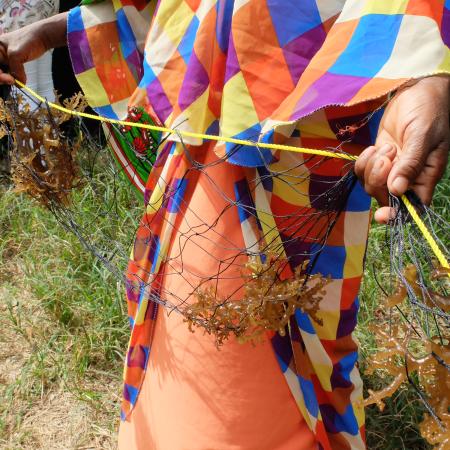
When seaweed farming started in Zanzibar, 30 years ago, it was hailed as a success story, giving women producers economic independence, a chance to engage in an activity away from their homes, and a way to assert their rights.
But this is no longer. With the progressive onset of climate change, rising sea temperatures and salinity variations have significantly reduced the amount of seaweed growing along the shores of Zanzibar, and are jeopardizing the livelihoods of the women seaweed producers. Using the traditional peg-and-rope technique, women work in appalling conditions. Yet their income is meagre and far from commensurate with their efforts: a kilo of dried Cottonii seaweed sells at only US$0.4, and one kg of dried Spinosum seaweed at only US$0.2.
Armed with these considerations, Dr Flower Msuya, myself and three other colleagues from Zanzibar, Tanzania mainland and Kenya, came up with the idea of introducing a new seaweed farming technology – deep water tubular nets – to improve seaweed productivity and women’s livelihoods and empowerment. This is how Sea PoWer started.
Tubular nets are long tubes made of fishing net material, in which seaweed bunches are placed at regular intervals. The nets holding the seaweed are then taken out to sea on a boat and placed in deeper waters (approx. 5-10m deep) by a snorkeler. The nets are held in place by ropes weighed by sandbags on the sea floor. At harvest, the nets and their contents are lifted up on a boat, brought ashore and opened to extract the grown seaweed.
However, the use of tubular nets presents a number of key challenges for women producers. Local culture and traditions regarding assigned gender roles in society prevent women from performing some tasks such as going out to sea and engaging in economic activities without asking for permission from their husband. As tubular nets are for deeper water, they also require either swimming or boat handling skills that most women do not have. Accounting for cultural factors as well challenging prevailing gender dynamics is therefore pivotal for the sensitive introduction of the innovation to women’s groups of seaweed farmers and for its sustained adoption before it is scaled out to the rest of the region.
Sea PoWer has helped the women seaweed producers become familiar with the tubular net technology, produce the higher valued seaweed, be knowledgeable and skilled in making and using tubular nets, and work in deep waters without fear.

